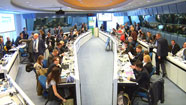On 5 April 2016 the JRC presented the interactive and collaborative online European Energy Efficiency Platform. This beta platform is conceived to fill the gap opened by scattered data and fragmented knowledge resulting from a rapidly growing energy efficiency market. It is expected to be both a one-stop shop for information retrieval and a meeting point for experts to exchange data and reduce redundant activities.
Assessment of Member States' building renovation strategies

The European building stock consumes approximately 40% of primary energy and it is responsible for 36% of the EU greenhouse emissions[1]. A significant reduction of building energy demand is a requisite to meet Europe’s GHG emissions reduction targets[2]. Buildings are a strategic sector for energy policy: it is among Juncker's Commission priorities and it is a pillar of the Energy Union as set by the 2015 Communication[3] The Energy Performance of Buildings Directive (EPBD) Directive together with the Energy Efficiency Directive (EED) and the Renewable Energy Directive (RED), defined a framework that creates the conditions for long term improvements in the energy performance of Europe's building stock.
In particular the Article 4 of EED requires Member States "to establish a long-term strategy beyond 2020 for mobilising investment in the renovation of residential and commercial buildings with a view to improving the energy performance of the building stock. That strategy should address cost-effective deep renovations which lead to a refurbishment that reduces both the delivered and the final energy consumption of a building by a significant percentage compared with the pre-renovation levels[4] leading to a very high energy performance".
In order to transpose the Directive and to increase the rates and depth of building renovation, the Member States were asked to develop their first renovation strategies and provide them with their third NEEAPs, due by 30th April 2014. One year after this deadline 31 strategies have been submitted to the European Commission (28 from MSs, 3 strategies from Belgium, and one from Gibraltar).
The present report summarises the assessment performed by JRC on the received strategies. The JRC undertook an assessment of 31 national/regional building renovation strategies submitted by the Member States (Deliverable D.2.1 Reports on assessment of each individual Member States' strategy). The analysis assessed and evaluated the compliance with all the items of Article 4 and checked if they were adequately addressed in each national renovation strategy.
The analysis provided an overview of the characteristics of Member States' national building stock (e.g. inventory, energy performance, etc.), highlighting data gaps and availability, and assessed the ambition levels of renovations determined and appropriateness of policies and measures (distinguishing between measures that have already been implemented and measures to be implemented) as well as energy savings expected. The summary of the individual assessments of the 31 renovation strategies submitted by Member States (Belgium communicated three regional strategies), including scores and targeted recommendations can be found in Annex A.
The aim of this report is to summarise the efforts undertaken by Member States in order to meet the requirements of EED Article 4, to provide an overview of the policies and measures chosen and of the overall strengths and weakness, and to identify best practices.
The assessment of the national building renovation strategies has highlighted that, in total, twenty-three out of the thirty-one submitted strategies (74.2%) satisfactorily addressed the main elements of EED Article 4. Ten strategies are fully compliant, with exemplary coverage of regulation requirements. Only six strategies were found to be not compliant.
In addition, it is worth mentioning that some of the non-compliant strategies were found for Member States traditionally strong in terms of energy efficiency measures and achievements, leading to considering the possibility that reporting failed to correctly depict the status of the building energy renovation in those countries (i.e. Austria, Germany and Sweden ) and their future plans.
Non-compliant strategies
According to our analysis, only six building renovation strategies out of thirty-one, do not meet the basic requirements of EED Article 4. This means that at least two requirements of Article 4 have been evaluated to be insufficiently covered in these strategies. This is the case of the strategies provided by the following Member States: Austria, Belgium Flanders, Belgium Wallonia, Bulgaria, Poland, and Portugal.
Non fully compliant strategies
The strategies from Germany and Sweden are deemed to be not fully compliant with Article 4; it means that they have been evaluated as not compliant in only one requirement of Article 4 (i.e. The German strategy for Article 4(b), the Swedish one for Article 4(d) only).
Almost fully compliant strategies (OR Acceptable strategies)
Thirteen strategies have been evaluated as "almost fully compliant"; it means that they have been assessed to be partially compliant (i.e. score=2) for maximum two requirements: Brussels Capital Region, Croatia, Cyprus, Denmark, Estonia, Finland, Gibraltar, Italy, Latvia, Luxemburg, Malta, Netherlands and Slovakia.
Fully compliant strategies and Best practices
Ten strategies resulted to be fully compliant to requirements of Article 4: Czech Republic, France, Greece, Hungary, Ireland, Lithuania, Romania, Slovenia, Spain and the United Kingdom.
The result of the appraisal exercise is considered especially positive as these were the first renovation strategy documents submitted by Member States and it is expected that their quality, and their actual implementation, will improve in future. Strategies will be revised in 2017, and every 3 years thereafter.
Nevertheless, the assessment shows that a number of Member States did not followed strictly the guidelines and missed some important part/concepts which would require improvements:
- With the exceptions of Finland and Belgium Flanders, no Member States reported plans following the "staged deep renovation" concept. More information and explanation on the idea and more references on the efficacy and examples of successful implementation could help Member States in the development of this renovation approach.
- In most of the cases Member States simply reported a reference to the cost-optimal methodologies, as required by the EPBD. It is recommended that key results of the cost-optimal analysis for the existing buildings would be properly integrated within the strategies.
- In terms of policy measures, only a few Member States reported "planned" measures for energy efficiency in buildings, while the vast majority reported only existing policies. As the strategies aim at having a "long-term" vision, Member States should be asked an effort to go beyond a simple inventory of the existing measures, providing, a vision/roadmap on the evolution of future policies and measures. Further guidance and support could be given on this point.
Furthermore, as a suggestion for the preparation of the next round of strategies, Member States could be explicitly asked to provide views on specific measures / policies: for instance, on refurbishment obligations, or incentives to demolition-reconstruction.
- A very few Member States provided a scenario analysis on the intervention options. It would be necessary to have alternative scenarios for building stock and to evaluate cost-effectiveness of different options under each scenario. This should in turn offer a tool to decide the most appropriate (cost-effective) level of intervention. In doing this exercise, it is important that the main assumptions are made explicit and discussed. Sensitivity analysis of the main parameters of the study should also be performed, while this was not done in any of the strategy.
- Not all Member States have provided a clear indication of their renovation targets. A description of potential energy savings and other benefits associated to the targets, when defined, is usually missing.
- The section related to forward-looking perspective to guide investment received the lowest average rating in the assessment exercise. In a number of cases information was not provided or was not in line with art 4 requirements and guideline indications. Additional guidance on this issue should be provided.
- Member States seem to neglect or undervalue the importance of R&D in the building sector: Only two strategies included this dimension (i.e. the United Kingdom and Germany).
- The majority of the renovation strategies failed to report and discuss issues beyond energy efficiency, for instance: indoor comfort/air quality, impact on construction sector, externalities.
- Non-residential building stock is not well covered and described. This is true for all the sections of the strategies. Member States should be asked additional effort in the collection of data and analysis of this specific segment of the building stock.
- Evaluation of the policies implemented should also be a section in the future strategies. Member States should prove to have monitored at least the most important measures and to share the outcomes in view of a policy evaluation exercise.
As a general remark, Member States seem to have developed each section of the long-term renovation strategy as a separate, stand-alone topic. A more correct view should have considered each section as related to the others in a conceptual flow.
Considering the linkages between the different sections (which reflect the different requirements of Article 4), should make Member States able to have a more systemic view and develop more coherent and complete strategies.

[1] https://ec.europa.eu/energy/en/topics/energy-efficiency/buildings
[2] COM/2014/015 final
[3] COM/2015/080 final
[4] In the SWD (2013)143 final, the Commission services have indicated that Member States should aim to encourage deep renovations of buildings leading to significant (typically more than 60%) efficiency improvements.




To quote this article use the follonwing format: